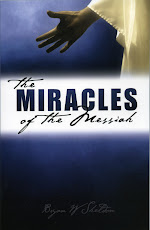The Death of the Messiah
The first element in the sign of the prophet Jonah is the death of the Messiah. The Sanhedrists, politically manipulating the Roman justice system, terminated the life of the Messiah at a bloody execution outside Jerusalem. The opponents of Jesus of Nazareth finally silenced the One who had weighed their lives, their work, and their culture, and found them wanting. Using a charge of insurrection, the Chief Priests in their capacity as the main mediators between Israel and Rome, finally obtained the execution order they had been seeking for more than a year. Anticipating the actions of the Sanhedrin and Pilate, Jesus knew that everything was to culminate in the sign of Jonah. Therefore, He began His final journey in the knowledge that His life would soon end. But His eyes were not so much on the cross, as on the ascension: “Now it came to pass, when the time had come for Him to be received up, that He steadfastly set His face to go to Jerusalem” (Luke 9:51). The writer to the Hebrews also says He looked for heaven and home: “Who for the joy that was set before Him endured the cross, despising the shame, and has sat down at the right hand of the throne of God” (Heb.12:2). Jesus tried to prepare the disciples by giving them additional detail of how He would be despatched. “Behold, we are going up to Jerusalem, and the Son of Man will be betrayed to the chief priests and to the scribes; and they will condemn Him to death, and deliver Him to the Gentiles to mock and to scourge and to crucify. And the third day He will rise again.” (Matt.20:18,19) It was less than a week before His death that He spoke for the first time of the mode of His execution, crucifixion!
The Trials of Jesus
The Pharisees’ rejection of Jesus as Israel’s Messiah was mainly the result of His rejection of the oral law. They felt they were fighting a battle, as did the Hasidim before them, against someone who was intent on bringing down the traditions they had sworn to uphold. However, to facilitate their aim and defeat their enemy, they were prepared to break many of the laws they were committed to defend. These events served to demonstrate that the Pharisaic Sanhedrists were unprincipled hypocrites. When it served their purpose, these so-called defenders and upholders of the oral law trampled over it with impunity. In their ambition to kill the One who branded them as “blind guides”, “whitewashed tombs”, “sons of hell”, “fools”, “serpents”, “lawless hypocrites” and “brood of vipers”, they threw aside any and all respect for the oral law, and rushed to judgement.
The section of the Mishnah called ‘Sanhedrin’ gives the rules for trying capital cases. These were the regulations that governed trials at the time of Christ. Some examples are as follows:
No arrest was allowed that was effected by a bribe.
Charges could not originate with the judges.
Judges were to be humane and kind.
Judges were not allowed to participate in an arrest.
There should be no arrests or trials after sunset.
There were to be no secret trials only public trials.
All trials should be in the Temple compound - normally in the chamber of hewn stones.
No prisoner should be scourged or beaten beforehand.
There should be no trials before the morning sacrifice.
All Sanhedrists may argue for acquittal but not all may argue for conviction – at least one must argue for acquittal.
Witnesses (2 or 3) must agree.
The accused is not allowed to testify against himself, and cannot be condemned on the basis of his own words alone.
An accusation of blasphemy is only valid if God’s name, YHWH, is pronounced.
The verdict could not be pronounced at night only during the day time.
Voting for the death penalty had to be done by individual count, beginning with the youngest, so that older members could not influence the younger.
The trial and guilty verdict could not occur the same time but had to be separated by at least 24 hours.
There had to be a gap of 3 days from the guilty verdict to the declaration of the sentence.
To summarise, the laws, formulated to govern the trial of those accused of capital crime, were humane and considerate. Every precaution was included to ensure a fair and proper trial. Where, when and how a trial was to take place was included in the law. It had to be during the daytime and open to scrutiny, and in a place where the public could observe. Justice had to be done, and had to be seen to be done. A member of the Sanhedrin was required to take up the defence of the accused. Witnesses, whose testimony agreed, were required. The accused would be forbidden to testify against himself – no forced confessions here! There had to be a break between the trial and the verdict, to give time for the proper consideration of the facts of the case. The law timetabled the sentence even further ahead – they built in the delays to allow time for the discovery of new evidence that might aid the case for the defence.
In the trial of Jesus of Nazareth, in their ambition to silence the one authoritative voice that opposed them, they ignored all these regulations.






No comments:
Post a Comment